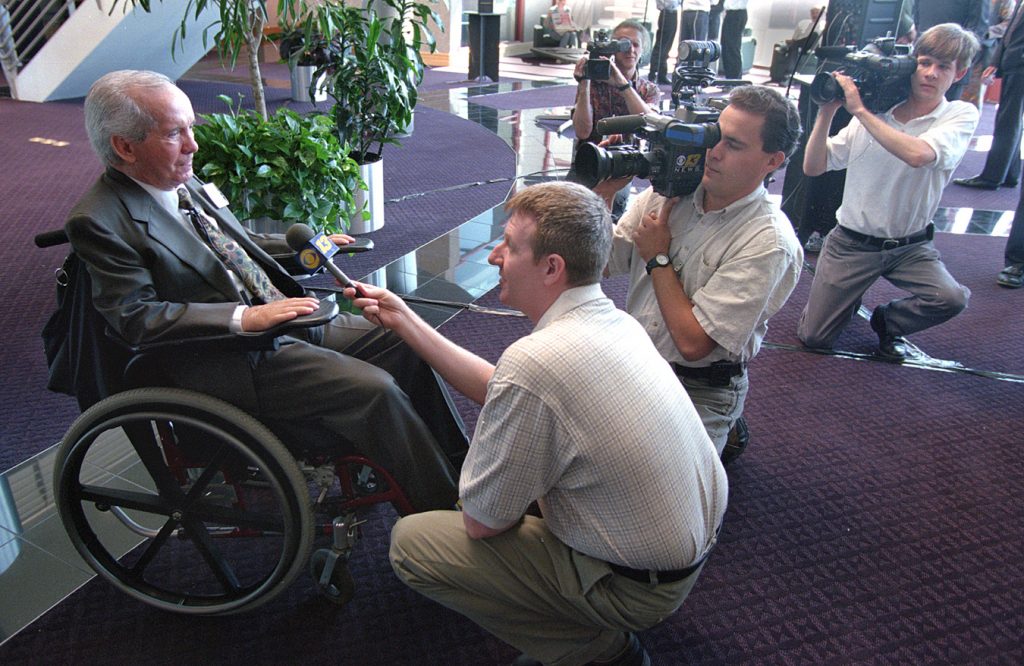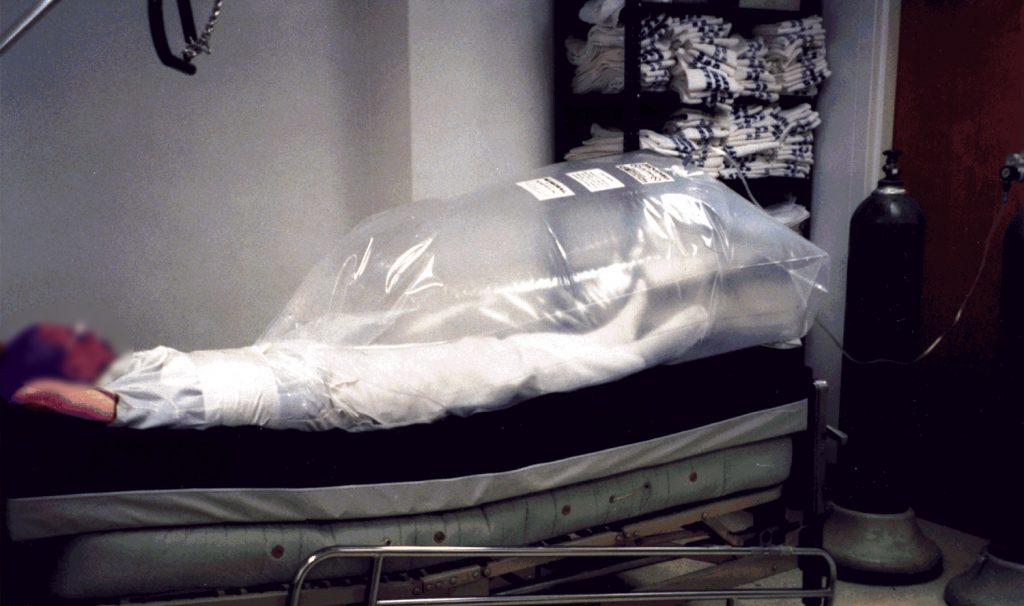
Download 150dpi JPEG image, ‘shoemakr.jpg’, 1.2MB
ALBUQUERQUE, N.M. — In the presence of wheelchair-bound Bill “Willie” Shoemaker — America’s winningest jockey until he suffered a severe spinal injury in an auto accident in 1991 — representatives of the Department of Energy’s Sandia National Laboratories signed a $5.76 million cooperative research and development agreement (CRADA) with California-based Numotech, Inc., a company that conducts research about wounds and then designs new treatments.
The CRADA, signed in mid-June, engages Sandia researchers to develop inexpensive sensors and lightweight pumps to simplify operation of Numotech’s unique oxygen-bath system for healing wounds, pressure sores, and pressure ulcers — quickly and with reduced scarring.
The product — helpful to the elderly, paraplegics, diabetics, and victims of burns and severe abrasions — should be available for home use in approximately three years. The treatment, called Topical Hyperbaric Oxygen Treatment (THOT), involves surrounding the injured part with a plastic bag filled with a slightly higher percentage of oxygen than the atmosphere provides, and at a slightly higher pressure. Towards this end, Numotech is contributing $1.51 million in cash to Sandia and $3.9 million in in-kind contributions. The remaining money is overhead and depreciation waived by DOE.
Among those attending the CRADA signing, in addition to Shoemaker, were Sandia executive vice-president John Crawford; Numotech president Dr. Robert Felton; technique discoverer and developer Dr. Madelene Heng, a professor at the UCLA School of Medicine and Chief of Dermatology at the Veterans Administration Center in Sepulveda, Calif.; and Michael Kleinman, board member of the non-profit Los Angeles-based Paralysis Project of America, which advances spinal research.
Pressure ulcers may cause amputation and death
According to Shoemaker, “People with spinal cord injuries are very susceptible to skin breakdown and hence, development of pressure ulcers. Statistics indicate that the incidence of pressure ulcers is about 50 percent amongst those with spinal cord injuries. The statistics get more ominous, though. Of those with pressure ulcers, an impressive number will be hospitalized as a direct result of that ulcer. Of those so hospitalized, an appalling number will die as a direct result of the ulcer.”
Shoemaker became interested in Numotech’s oxygen-bath technique several years ago when he took a week of the treatments and was sufficiently healed to return to the track — he’s now a trainer — immediately. “My doctors tell me that it would have normally taken four to five weeks to heal that sore,” he said.
Pressure ulcers, which are usually slow in healing and can be lethal, plague paraplegics, diabetics, and victims of burns and severe abrasions, all of whom suffer from loss of sensation in their bodies.
Pressure unfelt and therefore unrelieved can prevent blood from flowing in skin capillaries, says John Bode, a Sandia researcher who helped arrange the CRADA. Under such conditions, the skin breaks down in minutes and necrosis — the localized death of living tissue — can occur. Affected areas can go from necrotic to gangrenous, extend from skin to bone, and require amputation of the affected part. Such situations are avoided in normal bodies by the tendency to wiggle, which allows blood to flow through capillaries.

Reduce the number of amputations
“If our system were widely deployed, it would reduce the number of amputations caused by many medical conditions in this country by half,” said Felton, a 1977 University of New Mexico graduate who went on to achieve a doctorate in neurophysiology from UCLA. “One out of every three elderly people suffer from these problems. New Mexico will benefit immediately from being a pilot site with immediate access to the technology.”
The system, developed over 20 years by Heng, uses hyperbaric oxygen in a plastic bag around the affected part. In this technique, the oxygen is at only slightly higher pressures than ordinarily experienced.
The technique is different from oxygen-based healing sometimes attempted within metal chambers pressurized to two to three atmospheres and in which high oxygen concentrations are breathed by the patient. Pressurized chambers are expensive, and require extensive technical monitoring, upkeep, and cleaning. Overly lengthy treatments can be dangerous. Excessive oxygen delivered to a clotted wound, rather than stimulating healing, may feed microorganisms or create free radicals, harming the patient whose clotted blood is unable to produce the anti-free-radical components normally found in flowing blood, says Heng.
Lower pressures, lightweight equipment
Researchers of the Sandia-Numotech venture make use of much lower pressures, intend to develop accurate, simple, lightweight, inexpensive sensors and pumps, and hope to make the benefits of only mildly oxygen-rich care available to the public at far lower costs.
Sensors will permit automated or semiautomated monitoring for hospital nurses not specifically trained for the task and, in a later stage of development, enough simplicity of operation for patients to use the equipment at home. Safety features will include automatic shutdown if pressure levels are too high or if the predetermined treatment time is exceeded. For home use, a highly portable, user-friendly, inexpensive oxygen delivery system will be developed by Sandia.
Said Shoemaker in a prepared statement: “The process developed by Dr. Heng is now being perfected through a research effort supported by Sandia National Laboratories and Numotech, Inc. This joint effort envisions a process of health care where topically applied hyperbaric oxygen can be taken into the home, thus obviating the need for expensive equipment or hospitalization in many cases. I also learned that this process can be used for the treatment of burns, diabetic, venous, and arterial ulcers and as a post-surgical treatment to accelerate healing.”
“We’ll be trying to find out the optimum amount of oxygen to use for the treatment to be maximally successful,” says Bode. “Some chemical reactions work against each other, in control molecules that cause a reaction to go one way or another, and it’s not understood how to make it most effective in an engineering sense. We know the technique works, but we want to understand its boundaries.”
A simple, internal pressure sensor
The technique is, amazingly, currently operated by feel by Heng, said Sandia researcher Mark Vaughn. “She has to go around in her hospital and push with her fingers on the oxygen bag to estimate the pressure. And, she has to train every person who uses the technique to feel how much pressure is enough.”
Mark and project manger Keith Miller for starters have applied for a patent (through Sandia) on a spring-loaded internal pressure sensor, made of plastic “cheap enough to be thrown away.” The sensor is nonelectrical and can be read by a nurse who may be monitoring the health of a number of patients from 10 feet away.
“Heng’s is really an astonishing technique,” says Vaughn. “Even at the microscopic level, wounds seem to heal without scar tissue.”
In addition to its humanitarian and economic benefits, the project is of interest to Sandia because sensors developed to detect minute amounts of effluents expelled by healing wounds during the Topical Hyperbaric Oxygen Treatment are similar to ones used to detect minute amounts of trace elements from aging nuclear weapons to indicate their state of reliability.
Though other oxygen treatments are available, Numotech’s patent-pending chamber is shape-adaptable, portable and disposable; its pressures and oxygen percentage figures have been developed by one of the leading researchers in the field, and research is ongoing into systems which will improve the delivery and monitoring of THOT.
Sandia is a multiprogram DOE laboratory, operated by a subsidiary of Lockheed Martin Corp. With main facilities in Albuquerque, N.M., and Livermore, Calif., Sandia has major research and development responsibilities in national security, energy, and environmental technologies.
Sidebar: A battery-power pneumatic seat cushion for wheelchair-bound
Sandia previously worked with Numotech to develop a battery-powered pneumatic seat cushion designed to prevent pressure ulcers from occurring in persons confined to wheelchairs.
The collaboration began in 1994 under the New Mexico Technology Deployment Program (NMTDP) and involves scientists from the University of New Mexico who specialize in training and equipping persons with disabilities with assistive equipment.
It has helped improve a seat consisting, in part, of four pairs of air bladders, cyclically inflated and deflated by battery-powered pistons — a motion that creates the same wiggling effect that the body’s muscles do when operating normally, preventing sustained pressure on the buttocks, lower back or thighs. Such pressure can retard blood flow and oxygen exchange and cause tissue to weaken. In the right environment of moisture and temperature, bacteria can attack vulnerable tissues and cause pressure ulcers.
The device is currently at New Mexico State University’s Advanced Manufacturing Center for production studies. Funding for production of the device, as well as for the hyperbaric oxygen treatment, is being sought by Technology Ventures Corporation, a subsidiary of Lockheed Martin. The NMTDP was sponsored by the Defense Advanced Research Projects Agency (DARPA), the Department of Energy, and the State of New Mexico.
Technical contact:
Keith Miller,akmille@sandia.gov, (505) 845-8812